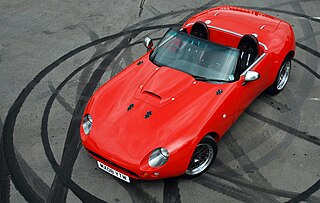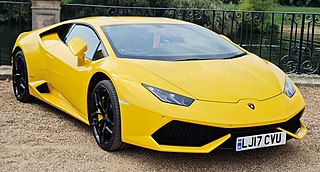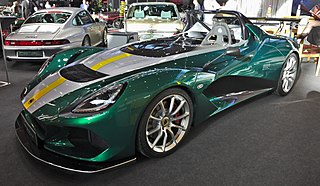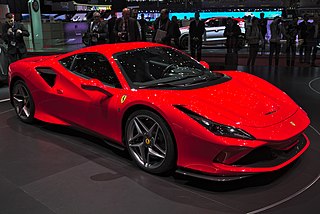
The Lotus Elise is a sports car conceived in early 1994 and released in September 1996 by the British manufacturer Lotus Cars. A two-seater roadster with a rear mid-engine, rear-wheel-drive layout, the Elise has a fibreglass body shell atop its bonded extruded aluminium chassis that provides a rigid platform for the suspension, while keeping weight and production costs to a minimum. The Elise was named after Elisa Artioli, the granddaughter of Romano Artioli who was chairman of Lotus and Bugatti at the time of the car's launch.

The TVR Tuscan Speed Six is a sports car which was manufactured by British company TVR from 1999 to 2006. The name pays homage to the original Tuscan which was introduced in 1967.

The Caterham 7 is a super-lightweight sports car produced by Caterham Cars in the United Kingdom. It is based on the Lotus Seven, a lightweight sports car sold in kit and factory-built form by Lotus Cars, from 1957 to 1972.

The Chrysler B and RB engines are a series of big-block V8 gasoline engines introduced in 1958 to replace the Chrysler FirePower engines. The B and RB engines are often referred to as "wedge" engines because they use wedge-shaped combustion chambers; this differentiates them from Chrysler's 426 Hemi big block engines that are typically referred to as "Hemi" or "426 Hemi" due to their hemispherical shaped combustion chambers. The corporation had been seeking a smaller and lighter replacement for its FirePower engines, in part because new styling dictates meant moving the engine forward in the chassis which negatively affected weight distribution.

The Aston Martin Vantage is a series of hand-built sports cars from the British automotive manufacturer Aston Martin. Aston Martin has previously used the "Vantage" name on high-performance variants of their existing GT models, notably on the Virage-based car of the 1990s. The modern car, in contrast, is the leanest and most agile car in Aston's lineup. As such, it is intended as a more focused model to reach out to potential buyers of cars such as the Porsche 911 as well as the exotic sports and GT cars with which Aston Martins traditionally compete.

Alpina Burkard Bovensiepen GmbH & Co. KG is an automobile manufacturing company based in Buchloe, in the Ostallgäu district of Bavaria, Germany that develops and sells high-performance versions of BMW cars. Alpina works closely with BMW and their processes are integrated into BMW's production lines, and is recognized by the German Ministry of Transport as an automobile manufacturer, in contrast to other performance specialists, which are aftermarket tuners. The Alpina B7 is produced at the same assembly line in Dingolfing, Germany, as BMW's own 7 Series. The B7's twin-turbo 4.4-litre V8 is assembled by hand at Alpina's facility in Buchloe, Germany, before being shipped to BMW for installation, and the assembled vehicle is then sent back to Alpina for finishing touches.

VXR was the branding for the high performance trim specification, used since 2004 for models in many of Vauxhall's car range in the United Kingdom. Holden has also used the VXR badge for some of its high-performance cars such as the Astra VXR, Insignia VXR, and the Commodore VXR.

The Lotus Europa S is a sports car built by the British company Lotus Cars from 2006 until 2010. It has a rear mid-engine, rear-wheel-drive layout and was designed to be a more comfortable variant of the driver-focused Lotus Elise and its derivative, the Exige. The Europa S revived the Europa nameplate previously used in the 1960s and 1970s.

The Ruf CTR also known as the CTR Yellowbird or simply Yellowbird, is a limited-production, high performance sports car manufactured by German automobile manufacturer Ruf Automobile. Introduced for the 1987 model year and based on the Porsche 911, the CTR featured an enlarged and highly tuned version of Porsche's 3.2 litre flat-six cylinder engine, lightened body panels, an integrated roll cage, upgraded suspension and braking systems, a custom-designed transmission, and several unique trim pieces such as polyurethane bumpers, and the use of the side-mounted oil filler necessitated by relocating the oil tank forward to clear the intercooler on that side.

The Bristol 412 is a car which was produced by British manufacturer Bristol Cars from 1975 to 1986. Variants were produced as the Bristol Beaufighter, from 1980 to 1993, and as the Bristol Beaufort, from 1984 to 1994.

The Dodge Viper is a sports car that was manufactured by Dodge, a division of American car manufacturer Chrysler from 1992 until 2017, having taken a brief hiatus in 2007 and from 2010 to 2012. Production of the two-seat sports car began at New Mack Assembly Plant in 1991 and moved to Conner Avenue Assembly Plant in October 1995.

The Melling Wildcat is a V8 powered sports car produced by Al Melling Sports Cars in Rochdale, Greater Manchester.

The Reliant Scimitar SS1 is an automobile which was produced by British manufacturer Reliant from 1984 to 1995.

The BMW M2 is a high-performance version of the BMW 2 Series automobile developed by BMW's motorsport division, BMW M GmbH. As the 2 Series replaced the 1 Series coupé and convertible models, the first-generation M2 was marketed as the most basic M model in the range.

The Lamborghini Huracán is a sports car manufactured by Italian automotive manufacturer Lamborghini replacing the previous V10 offering, the Gallardo. The Huracán was revealed online in December 2013, making its worldwide debut at the 2014 Geneva Auto Show and was released in the market in the second quarter of 2014.

The McLaren 650S is a British sports car designed and manufactured by British automobile manufacturer McLaren Automotive. It was announced in February 2014 as a new model, but based on the existing MP4-12C with 25% new parts, and was formally unveiled at the 2014 Geneva Motor Show.

The Viper engine is a high-performance naturally-aspirated pushrod 2 valve-per-cylinder 90° V10 engine designed by Chrysler but with aluminum block castings designed by Lamborghini for use in the Dodge Viper. Despite its large displacement, it is based on the Chrysler LA V8.

Volkswagen R is the brand used by the German auto manufacturer Volkswagen to indicate a sport or high performance model. An "R" badge is placed on the grille, front fenders and trunk of R-model vehicles to indicate the vehicle's trim level.

The Lotus 3-Eleven is a sports car produced by British car manufacturer Lotus Cars. The car is available as a racing version as well as a normal road legal version.

The Ferrari F8 is a mid-engine sports car produced by the Italian automobile manufacturer Ferrari. The car is the successor to the Ferrari 488 and pays homage to the last 45 years of Ferrari’s mid-engine V8s. It was unveiled at the 2019 Geneva Motor Show.




















